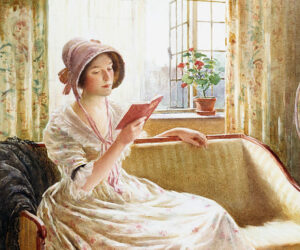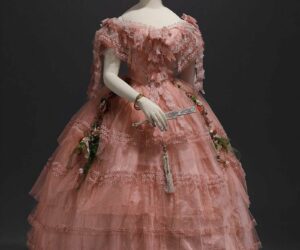
Fashion Wizard, Honey Badger, Icon: Charles Frederick Worth
1 – It’s time for #ThreadTalk & we are all about Charles Frederick Worth.
From poverty in Lincolnshire to the opulence of rue de la Paix in Paris, Worth challenged Victorian sensibilities & defined haute couture.
Part wizard🧙♂️, part honey badger🦡, 100% 🧵#ThreadTalkicon.
2 – We know fairly little about Worth, not just his early days, but his intimate life.
We know his work, of course. But there are precious few letters or correspondences to build upon. Which is curious given Victorian tendencies to novelize just about anything.

3 – What we do know is that by the age of 12, Worth was already in London working w/textiles & they changed his life.
I consider that moment an artist meeting their medium, & it was certainly the era to do so (see the swatch book below). By 21, he moved to Paris with just £5.

4 – Worth found employment at the fashion house Gagelin, where he met his future wife & lifelong business partner Marie Vernet (L).
The young Englishman was an anomaly among the French, but he became their chief salesman and helped propel the house to great notoriety.
5 – With Worth, Gagelin soared. His talent for spectacle that changed the game: live models, fashion shows, & he even gave models prizes.
Now, fashion becomes a living, breathing event–to see and to be seen–for women in Paris and beyond, so long as they pay. But he wants more.

6 – By 30, Worth was a household name & at 37 he parted ways with Gagelin to start his own fashion house with Otto Bobergh, called Worth & Bobergh.
Their collaborations are often monochrome, but vividly darted, cut, and folded, like this lilac dainty from the Met that I 💜

7 – The partnership did not last, though you can see hints of the future in the color combinations like this lovely collab from 1866-1868 that’s currently at the PHL Museum of Art. Bobergh did well for himself and returned to Stockholm & Worth’s star continued to rise.

8 – And this is where we take a pause. Because to our contemporary eyes, none of this seems odd.
But then, didn’t even have a word for this occupation. Worth started his own salon. And saw women. And he TOUCHED THEM. With his bare hands.
Even in France, it was scandalous.

9 – (Male) contemporaries deemed Worth “man-milliner”–not a complimentary at all. As Dr. Abigail Joseph explains in her fabulous article “A Wizard of Silks and Tulle” (which is central to my thread) they use othering terms outside the masculine, horrified at his occupation.

10 – See quote from Larousse, via Dr. Joseph: “let us leave to feminine hands… the delicate cares of an industry which requires, we know, fairy-like fingers, not the build of an athlete, to be practiced properly and above all decently.”
Ew, David. Tempest, designed for Worth.

11 – So they have to come up with a word for what he is. There is just the word couturiere–a woman’s occupation.
So he becomes a couturier & he does not give any effs b/c he’s making art. And 💵💵💵. And dresses like this. And he has barely passable French. Because LOL.

12 – Worth’s clientele was as famous as they get, including Empress Eugenie herself (below).
Once she turned his eye to him, dresses that once might have been a few 100 francs were 2,000+ much to the chagrin of all the other dressmakers who did not take kindly to the Anglais…

13 – So. The honey badger.
Worth was… well, opinionated? He had vision, or as we might say today, absolutely no filter. And he was a noted control freak.
Consultations were in his Paris salon–with the only exception being Empress Eugenie.

14 – No matter the company, he behaved in a way we might consider rather cliche: sitting in silence as he stared, appraising the woman’s form, then muttering about colors and patterns, legs crossed, cigar in hand, half in a dream, awaiting inspiration.

15 – Dr. Joseph: If Worth was not quite a sinister, “evil aesthete,” he was a very dictatorial & often unpleasant one… he was a “most pronounced poseur” whose “affectations were extravagant almost to grotesqueness. At times he was arbitrary, brusque, and even brutally rude”.

16 – But it worked.
Women flocked to Worth from around the world, & Americans were some of his favorites because they paid well. To meet the demands, he began using patterns to base dresses on–essentially the beginnings of pret-a-porter. (1870 here)

17 – Worth became so popular that Marie and Charles’ two sons (Gaston & Jean-Philippe) got in on the business & carried on some of the work.
But in case you thought we were going to go a night without horrendous colonialist crap, here’s JP being an appropriative turd! 🤮

18 – Was Worth queer? Dr. Joseph explains we only have the ephemera to judge, but that his queerness certainly exists in his occupying of these spaces outside the norms, & his relationship to form, fabric, & luxury. I have more thoughts…

19 – I also read Worth as neurodivergent, likely autistic. I know it’s hard to diagnose someone of another era. But I also live with an autistic person who saw a car at 18 months, & has never been the same. Reading this was like reading my son’s life through a different lens.

20 – Queer, neurodivergent, whatever he was, Worth was an icon, and singular.
After a life of working at breakneck pace, suffering migraines, & ill health, he passed away the master of a fortune & an empire of fashion, at 69. (Day dress, dinner bodice:c. 1875)

21 – So, some dresses. Let’s begin with this Worth & Bobergh number that is 100% Belle’s dress from Beauty and the Beast. You can’t convince me otherwise.
I mean. 👀 I adore yellow dresses. And this one is so yummy. It dates from between 1866-68, silk satin, silk tulle.

22 – How about a dolman in a color so vivid the photo looks broken? The further in Worth’s career, the bolder he gets with his colors, but he has always loved contrast. And I love the way this looks ancient and yet modern. A conceit he’s always loved (the new old/old new). c 1885

23 – This afternoon dress is in my 🎵jewel tones🎵so you know I’ve got to share it with enthusiasm. This is more practical, but I adore it all the same. You see Worth’s real architectural strengths here: lines and shapes, color blocking, pleats. Stunning. 1874.

24 – I luuuuurve orange. And IMHO, we don’t see enough of it. This may be a JP dress, but it’s hard to tell because the Met needs to… focus a little on their copy vs. their pasting. Ahem.
I think this is silk velvet? The black bows? Heaven. 1889.

25 – Speaking of ephemeral. This dress dates from the height of Worth’s time at the helm, 1877. And it’s an effing masterpiece. Snatched waist, layers of satin, that cascading lace, the brocade.
This is a dinner dress. I would ruin it before I got to the table, TBH.
26 – This blue. I mean. It’s THE BLUE. We’re talking silk taffeta. We’re talking mounds. We’re talking walking sculpture here, folks. This is no longer a dress, this is art. And it’s early for Worth, too: 1872.
Originally tweeted by Natania Barron (@NataniaBarron) on June 7, 2021.











